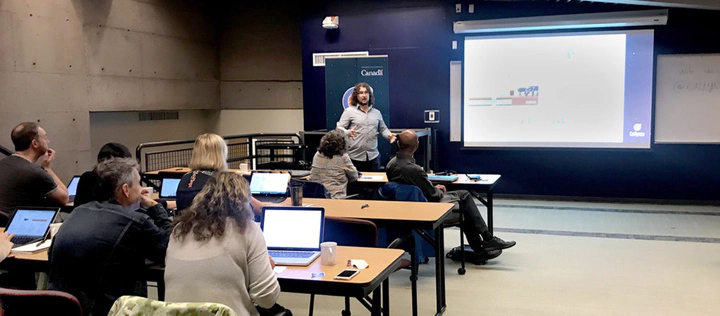The People Behind Callysto: Meet One of Our Lead Instructors, Joshua

As part of our ongoing blog series to introduce you to the people of Callysto, today we’ll introduce you to the Callysto project lead workshop instructor for Alberta, Saskatchewan and Ontario: Joshua Lecoupe. A lifelong science and fitness fanatic, Josh is tapping into his knowledge (and stamina) to help teachers understand how to use Callysto in the classroom while working alongside our team of developers and mathematicians.
What do you do?
I have two jobs right now, in addition to my work with the Callysto project. I am a STEM Integration Specialist with STEM Learning Labs, as well a Strength and Conditioning Coach at Winsport. I’m also the lead instructor for the Callysto teacher training workshops in Alberta, Saskatchewan, and Ontario.
Have you ever worked as a school teacher?
Yes, for about a year, I taught at Bishop Grandin in Calgary, where I focused on Physics, Math, Physical Education and Sports Performance. I also continue to teach introductory computer science courses part-time at West Island College.
Describe your role with Callysto?
As one of the lead instructors, my job is to bridge the gap between the developers, coders and teachers through facilitating one-day teacher training workshops and presentations. Basically, I am here to make the workshops as teacher-friendly as possible.
Do you know how to code?
Yes, I do. While I am biomechanist, not a computer scientist by training, the data analytics for my undergrad thesis project was done using MATLAB. A very similar language to Python, which is the computing language that the Callysto project is based around.
What do you enjoy about this project?
When I was in middle school, I struggled to be engaged by written text on paper. I definitely didn’t gain enough exposure to computing science and coding in grade school either. Although, when traditional subjects are taught with Jupyter Notebooks, you are getting a multi-modal learning experience that also exposes students to the fundamentals of coding, that is so powerful!
Why does Callysto matter to you as a teacher?
Callysto represents a purposeful shift towards a 21st-Century classroom. The use of science, technology, engineering, and mathematics (STEM) education and computational thinking is becoming more prevalent in today’s society. This project helps to bridge the gap between theory and practice.
As a teacher, should you be scared to learn Callysto?
No, the whole project team is here to support teachers. You don’t need to know how to code in order to use Callysto. If you want to learn how to code, then you can learn Python through the user-friendly integrated tutorials. But we are here to teach you how to effectively integrate the tool into your teaching practice and show you how to access the available content that is ready for immediate use within the classroom.
We have over 30 developers creating online learning modules that align with provincial curricula, back with resources and tutorials to make it a practical teaching tool. I promise, if you attend one of our workshops you will walk away with a better understanding of computational thinking and a new perspective on how to integrate open source technology into your teaching practice.
What is the best way to use Callysto in the classroom?
Well, there are many great options. First, off I think it’s a great way to showcase a student’s work as they are able to express themselves while integrating various media and data resources. You can also use it as an online, interactive textbook, lesson or unit plan.
Or it can be used as an extension project for students who want to explore the intricacies and functionality of computing languages, and really tinker and explore. I utilize the tool with the kids in my classes teach coding because it provides a versatile medium for reflection, submission and assessment.
Aside from teaching, do you have any secret talents?
In my spare time, I enjoy Olympic Weightlifting. I also really enjoy scuba diving, snowboarding and building aquariums for my tropical pets!
What’s the last book you read?
Currently, I’m reading Weapons of Math Destruction by Kathy O’Neil. It’s about the use of math and big data, which really lines up well with my career.